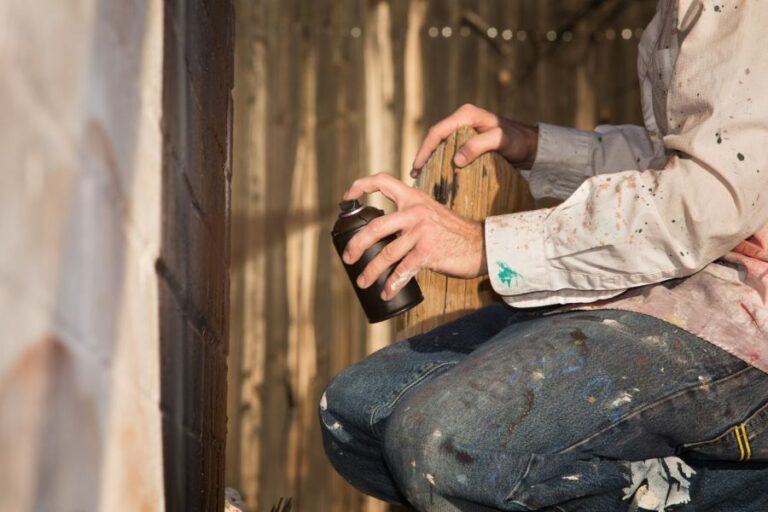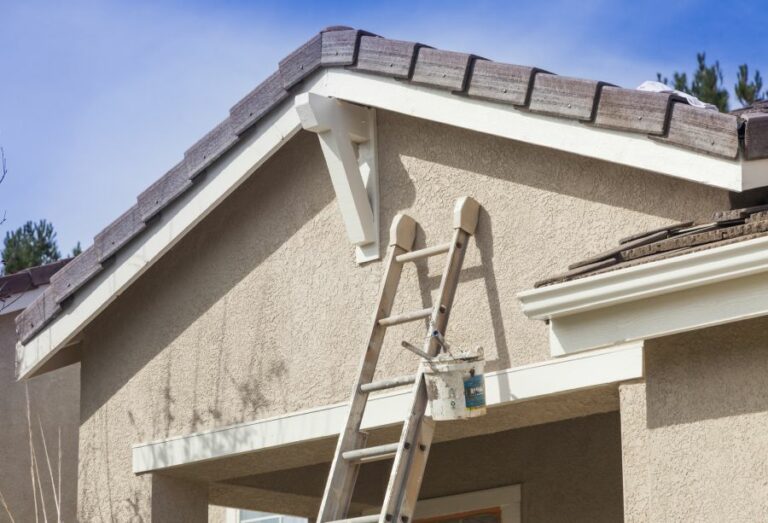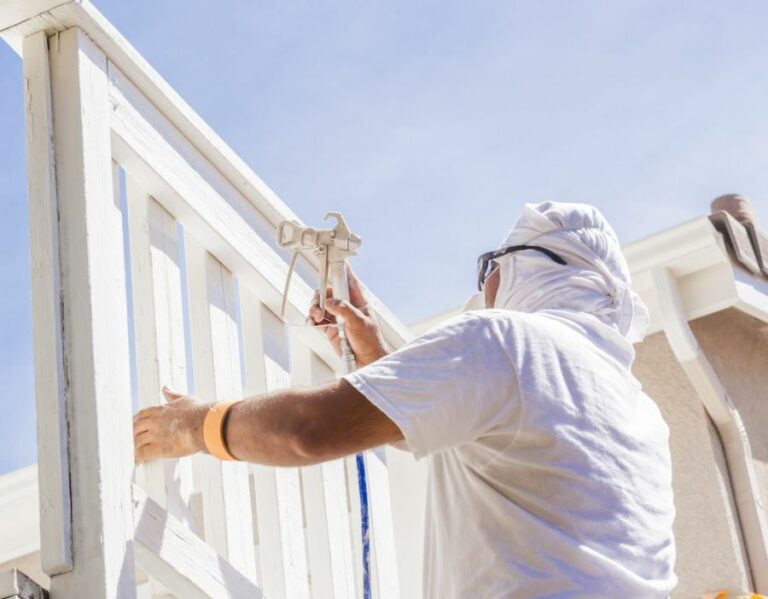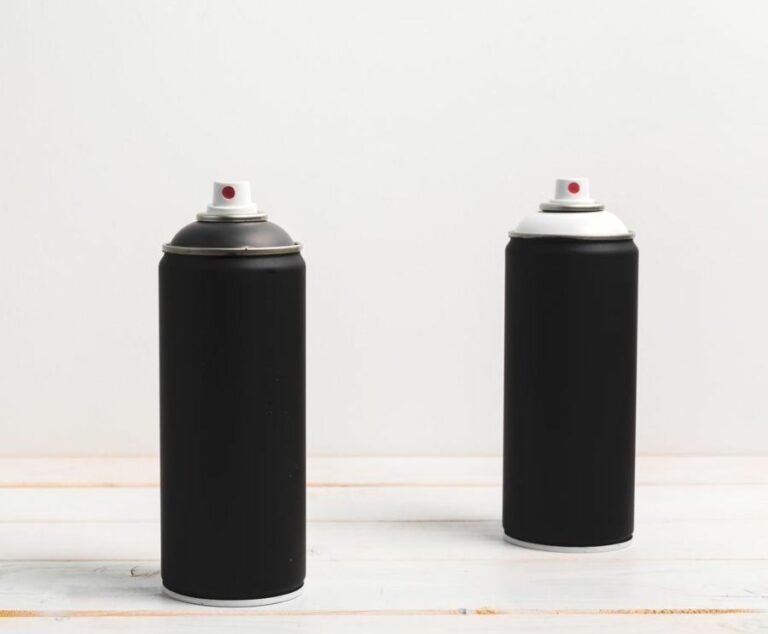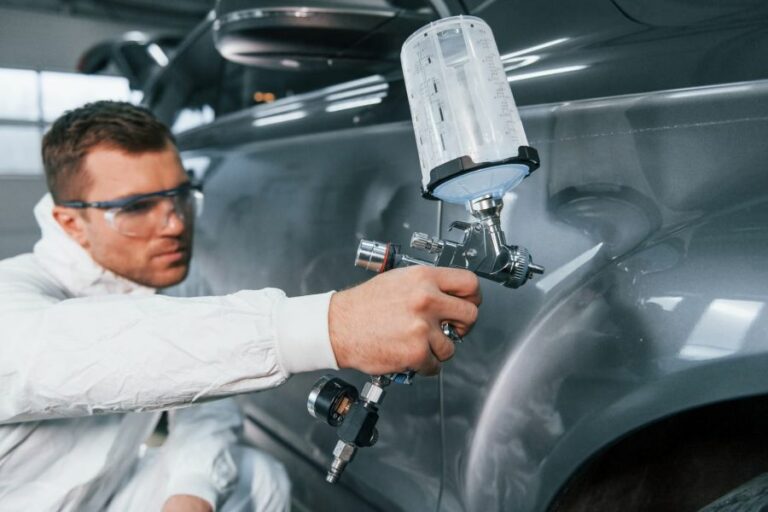Top Tips To Make Your Spray Paint Last Longer. What Pros Say
Are you tired of your spray paint projects fading or chipping away over time? Don’t worry; we’ve got you covered! With our top tips to make your spray paint last longer, we will help you enhance the durability and longevity of your artwork. Read on and watch your creations stand the test of time like never before!
Top tips to make your spray paint last longer:
To make spray paint last longer, ensure proper surface preparation by cleaning and sanding the material. Use high-quality paint products, apply a primer, and follow a proper spray painting technique with multiple thin layers. Allow adequate drying and curing times, apply a protective topcoat, and store paint cans properly. Maintain the painted surface for extended durability.

Ready to preserve the life of your spray paint and keep your artwork vibrant for years to come? Continue reading to unveil our most effective tips and tricks that will ensure your spray paint longevity and quality. Don’t let your creativity fade away. Read on!
Contents
- 1 Expert Strategies for Extending Spray Paint Durability
- 2 Prolonging the Lifespan of Your Spray Paint
- 3 Enhance Spray Paint Performance with These Tips
- 4 Discover the Art of Mastering Spray Painting Techniques
Expert Strategies for Extending Spray Paint Durability
• Proper Surface Preparation
A successful spray paint job always starts with proper surface preparation. Ensuring a clean, smooth, and dry surface allows the paint to adhere better to the material, ultimately extending the paint’s lifespan.
Use a degreaser, soap, and water or a specialized cleaning solution to remove dirt, grease, and other contaminants from the surface. In addition, sanding the surface with medium-grit sandpaper will help create a better bond between the paint and the material.
Remember to always wear proper protective gear when sanding or using chemical cleaning products.
• Use Quality Paint Products
Investing in high-quality paint products can significantly impact the durability and longevity of your spray paint project. Cheaper paints often contain lower-quality ingredients and may lack the necessary additives to make them last.
Choose paints with UV resistance, rust protection, and other beneficial features to help protect your paint from fading and damage. Take the time to research reputable brands and read customer reviews before purchasing.
• Primer Application
Applying a primer before spray painting is crucial for protecting the surface and promoting paint adhesion. Primer creates a uniform base layer onto which the paint can adhere and prevents the material from absorbing the paint, which may cause an uneven finish.
Moreover, primers can also provide additional benefits, such as rust prevention, stain blocking, or mold resistance, depending on the product you choose.
The American Institute for Conservation recommends using a primer when painting on metal surfaces, as this will greatly improve the paint’s bond and durability.
• Proper Spray Painting Technique
Achieving a long-lasting spray paint finish demands a proper painting technique. Keep these tips in mind for optimal results:
- Shake the can well before starting and intermittently while spraying: this ensures the paint is thoroughly mixed and all the components are evenly distributed in the can.
- Maintain an appropriate distance from the surface: typically around 10 to 12 inches. This prevents the paint from dripping or forming an uneven coat.
- Spray paint in multiple thin layers: lighter coats of paint dry faster and are less likely to chip or peel. Wait for the recommended drying time between each layer, as specified on the paint’s label.
- Use consistent, overlapping strokes: go slightly beyond the object’s edges and maintain a steady pace to avoid creating stripes or paint buildup.
• Proper Drying and Curing Times
Allowing ample time for the paint to dry and cure is essential for ensuring its longevity. While the drying time varies depending on the paint’s brand and formulation, most spray paints require at least 24 hours to dry completely, and it may take even longer in humid conditions.
Refrain from touching or handling the painted surface during this time to avoid leaving fingerprints, dents, or other damages.
Moreover, it can take up to a month for the paint to fully cure and harden. Be particularly careful during this period, as the paint’s surface may still be susceptible to scratches and other damages.
• Protective Topcoats
Applying a clear protective topcoat, such as a sealant or clear varnish, can add an additional layer of protection to your newly painted surface. These topcoats offer various benefits, including increased resistance against scratches, chemical exposure, UV radiation, and more.
Choose a topcoat compatible with your paint, and ensure that the paint has fully dried before applying.
Keep in mind that some topcoats can alter the paint’s appearance, such as adding a glossy or matte finish. Test the product on a small or inconspicuous area before applying it to the entire surface.
• Proper Storage and Maintenance
Storing your spray paint cans properly can make a difference in the paint’s shelf life and performance. Store cans in a cool, dry place, ideally between 50 F and 90 F, away from direct sunlight and extreme temperatures. Always place the cap back on the can after each use to prevent clogging and drying out.
Additionally, maintaining the painted surface can also extend its lifespan. Regularly clean and inspect for signs of wear and tear, and consider reapplying your protective topcoat as needed.
By following these top tips, you can ensure your spray paint project remains vibrant and durable for years to come. Prioritize surface preparation, invest in quality products, and practice proper techniques to achieve professional, long-lasting results.
Tip | Description |
|---|---|
Store spray cans properly | Keep your spray paint cans in a cool, dry place, away from direct sunlight and extreme temperatures, to extend their shelf life. |
Shake the can well | Shake the can vigorously for at least one minute before using it to ensure the paint is well mixed and to prevent clogging of the spray nozzle. |
Use a spray paint handle | |
Apply multiple thin coats | Instead of one thick coat, use multiple thin coats of paint with proper drying time in between layers to achieve a long-lasting, even finish. |
Prep the surface properly | Clean and dry the surface before painting, and use a primer, if necessary, to ensure better adhesion of the paint and a longer-lasting result. |
Use a clear topcoat | Apply a clear protective topcoat to the painted surface after it dries to protect the paint from damage and extend its life. |
Clean the nozzle after use | After painting, turn the can upside down and spray for a few seconds to clear the nozzle of any residue, ensuring it works well for future uses. |
Prolonging the Lifespan of Your Spray Paint
Spray paint is a versatile and convenient tool for all sorts of DIY and professional projects. However, to get the most out of your spray paint, it’s important to take certain measures to ensure its durability and longevity.
• Preparing the Surface
Before you begin spray painting, it’s crucial to thoroughly prepare the surface you’ll be working on. Proper surface preparation is critical to ensure that the spray paint bonds well, and it will significantly affect the longevity of your paint job.
– Clean the Surface
Ensure the surface you’ll be painting is clean and free from dirt, grease, and grime. Use soap and water, or a suitable cleaning solvent, to remove any contaminants from the surface.
– Remove Rust and Old Paint
For metal surfaces, remove any rust or loose, flaking paint using a scraper, wire brush, or sandpaper. This step will ensure that your new spray paint job adheres well and doesn’t peel or chip off prematurely.
– Sand the Surface
Sanding isn’t just for wooden surfaces – it’s also essential for achieving a smooth finish on metal and plastic surfaces. Use medium-grit sandpaper to abrade the surface lightly, ensuring a better bond between the paint and the object. After sanding, wipe the surface with a clean cloth to remove any dust.
• Use a Primer
Using a primer is highly recommended, as it provides several benefits that contribute to the longevity of your spray paint job. Primers help to create a uniform surface, ensure better adhesion, and improve the final appearance.
– Select the Right Primer
Choose a primer that is appropriate for the material you’ll be spray painting. There are different primers available for various surfaces like metal, plastic, or wood. Many spray paint brands even offer primers that are designed to work specifically with their spray paints.
– Apply the Primer
Apply a thin and even coat of primer, allowing it to dry as per the manufacturer’s instructions. Make sure to cover the entire surface for consistent results. If necessary, apply a second coat of primer for better coverage.
• Use Quality Spray Paint
It’s worth investing in good-quality spray paint to ensure a durable and long-lasting finish. Look for paint that offers excellent adhesion, coverage, and UV resistance.
– Shake the Can Well
Before spraying, shake the can vigorously for at least one minute. This step ensures that the paint is mixed well, which will help you achieve a consistent finish.
• Proper Techniques for Applying Spray Paint
The way you apply the spray paint can make a significant difference in the final appearance and longevity of your paint job.
– Spray Evenly
Keep the can at a consistent distance (usually about 10-12 inches) from the surface while spraying. Maintain a steady speed as you spray, moving horizontally or vertically – never in a circular pattern. This technique will help you achieve an even, streak-free finish.
– Apply Thin Coats
It’s better to apply multiple thin coats of paint rather than one thick layer. Thick layers of paint are more likely to crack, peel or chip over time. Allow each coat to dry as per the manufacturer’s instructions before applying the next coat.
• Seal and Protect Your Paint Job
Applying a clear coat or sealant can offer additional protection and longevity for your spray paint job.
– Choose the Right Clear Coat
Clear coats are available in various finishes, such as matte, satin, or gloss. Select the one that best suits your desired appearance. Ensure that the clear coat is compatible with the spray paint you’ve used.
– Apply the Clear Coat
Once your final layer of spray paint has dried, apply the clear coat in light, even layers, ensuring complete coverage. Allow it to dry as per the manufacturer’s instructions.
By following these steps and techniques, you can ensure that your spray paint job lasts longer and maintains its appearance for years to come. Remember that proper preparation, the use of quality products, and careful application are key factors in achieving a long-lasting spray paint finish.
Step | Instructions |
|---|---|
1 | Prepare the surface: clean it, sand it, and make sure it’s dry and free of dust, grease, and rust. |
2 | Apply a primer to the surface to help the spray paint adhere better and provide a smooth, even coat. |
3 | Shake the spray paint can well before using it, and continue to shake it throughout the painting process. |
4 | Hold the spray paint can at the right distance: typically 8-12 inches away from the surface. |
5 | Apply thin, even coats, allowing each coat to dry before applying the next one. |
6 | Wait for the paint to fully cure, following the drying time indicated on the can’s label. |
7 | Apply a protective clear coat, if necessary, to provide extra durability and protection. |
8 | Store any leftover spray paint in a cool, dry place, and avoid exposing it to extreme temperatures or direct sunlight. |
Enhance Spray Paint Performance with These Tips
Spray painting is an efficient and versatile way to apply paint to a variety of surfaces, from home decoration and artistic projects to automotive and industrial applications. However, achieving a smooth, professional finish can be challenging, especially for beginners.
• Choosing the Right Spray Paint
The first step in achieving a better spray paint application is selecting the right type of paint for your project. Spray paint comes in various formulations, each designed for specific surfaces and conditions.
To achieve optimal adhesion and durability, it’s crucial to use a paint specifically formulated for your material, whether it’s metal, wood, plastic, or another surface.
– Recommendations for Paint Selection
- Use well-known, reputable brands like Krylon, Rust-Oleum, and Montana Cans. These companies have invested in research and development to create reliable spray paint formulas that deliver consistent results.
- If possible, select a paint with built-in primer. This will provide a better base for the color coat, improving adhesion and providing a uniform finish.
- Ensure you are using a paint designed for indoor or outdoor use, depending on your project’s location. Some paints contain UV-resistant properties or moisture-resistant additives, which are essential for exterior applications.
• Preparing the Surface
A clean, smooth surface is essential to a professional-looking paint finish. Proper preparation will help eliminate common problems like uneven paint coverage, peeling, and cracking.
– Surface Preparation Tips
- Use fine-grit sandpaper (220 to 400 grit) for sanding the surface and removing any imperfections, such as scratches or rough patches. This will also help the paint adhere better.
- Wipe down the surface with a tack cloth or damp rag to remove any dust or debris.
- Apply a compatible primer if it is not included in your spray paint. This will ensure a smooth, even surface for the paint to adhere to.
• Proper Spray Paint Technique
Developing an effective spray painting technique is crucial to achieving a professional finish. Here are some tips and best practices to help you get started.
– Tips for Effective Spraying
- Shake the can vigorously for at least one minute before use and occasionally during spraying. This mixes the paint and propellant for a more consistent application.
- Hold the can approximately 10 to 12 inches away from the surface. This will provide even coverage and prevent paint from running or dripping.
- Begin spraying off the edge of the surface, and move in a smooth, steady motion across the surface. This ensures a uniform finish with minimal overspray and buildup.
- Apply multiple thin coats, allowing each coat to dry before applying the next. This will help prevent sagging or wrinkling and create a more durable finish.
- Keep your arm parallel to the surface while spraying, maintaining a consistent distance as you move across the surface.
• Proper Ventilation and Safety Precautions
Spray painting in a well-ventilated area is essential for safety and achieving the best results. The fumes from spray paint can become concentrated in enclosed spaces, posing a health risk and negatively affecting the paint’s finish.
– Safety Precautions and Recommendations
- Open windows and doors to ensure adequate airflow, or work in an outdoor space.
- Use a respirator or face mask to protect yourself from paint fumes, and wear safety goggles to protect your eyes.
- Cover the surrounding area with drop cloths or plastic sheeting to prevent overspray and make cleaning up easier.
• Caring for Your Spray Paint Can
Using your spray paint can correctly and maintaining it properly is key to ensuring consistent, quality results.
– Maintenance Tips
- Always store the can in a cool, dry place, away from direct sunlight or extreme temperatures.
- Clean the nozzle area after each use by turning the can upside-down and spraying for a few seconds. This clears out any remaining paint and prevents clogging.
- If the nozzle does become clogged, try removing it and rinsing it with acetone or paint thinner. You can also swap it with a replacement nozzle if necessary.
- When you have finished using the spray paint, store the can with the nozzle cap on to protect it from dust and debris.
By following these expert tips and recommendations, you can improve your spray paint technique and achieve professional results for your projects. With the right paint, proper preparation, and attention to detail, you can transform your work with the power of spray paint.
Discover the Art of Mastering Spray Painting Techniques
Are you excited to unleash your creativity through a spray painting project? Want to know the secret to achieve smooth, even, and professional-looking results?
You’re in the right place!
In this comprehensive guide, we’ll reveal the most effective techniques, tricks, and best practices to help you succeed in your spray painting endeavors. Let’s dive in!
• The Power of Preparation: Cleaning and Sanding
A successful spray painting project starts with thorough preparation. Begin by cleaning the surface you plan to paint. Remove dirt, grease, oils, and any other contaminants using a gentle detergent and warm water.
For the best adhesion and smoothest finish, sanding is critical. Start by choosing the correct sandpaper grit. A coarse grit (80-100) is ideal for removing old paint, while a finer grit (220-240) works best for scuffing and smoothing surfaces.
Always sand in the direction of the grain, and remember to clean the surface with a tack cloth after sanding.
*Tip: Attention to detail in this preparatory stage will greatly impact the final appearance of your project, so don’t skimp on the effort!
• Selecting the Right Spray Paint
Choosing the appropriate spray paint for your project is essential. As a general rule, go for a high-quality, well-known brand to ensure consistent coverage and long-lasting results.
There are various types of spray paint, including enamels, lacquers, and latex-based paints. Your choice will depend on the material you’re painting and the desired finish.
Recommendation: For most DIY projects, a rust-preventative and durable enamel is a great choice.
• Proper Environment and Conditions Matter
Temperature and humidity play significant roles in the success of your spray painting project. Avoid working in extremely hot, cold, or humid conditions, as these can negatively affect the paint’s adhesion, drying time, and overall appearance.
The ideal temperature range for spray painting is between 50-90 degrees Fahrenheit (10-32 degrees Celsius), with a relative humidity of 40-70%.
If you can’t work outdoors or in a well-ventilated area, make sure you have adequate ventilation and take necessary safety precautions, such as wearing a respirator, goggles, and gloves.
• Perfecting Your Spray Painting Technique
– Holding the Can Correctly
For optimum results, hold the spray can about 8-12 inches away from the surface. Ensure the can is upright to prevent the paint from sputtering and creating an uneven finish.
– Start with a Test Spray
Before you begin, it’s wise to practice on a piece of scrap material or a hidden area of your project especially if you’re not familiar with using spray paint. This will help you determine the appropriate spraying speed, avoid drips and runs, and achieve consistent coverage.
– Employ the “Sweep” Technique
To get professional-looking results, you’ll want to master the “sweep” technique. Start by pressing the nozzle slightly away from the surface, then sweep gracefully across while maintaining a steady and consistent speed.
Release the nozzle at the end of each pass, and then overlap each previous stroke by about 50%. This ensures even coverage and minimizes the risk of drips.
*Recommendation: For vertical surfaces, use horizontal passes to minimize drips, and for horizontal surfaces, use vertical sweeps.
• The Merits of Multiple Thin Coats
Patience pays off when it comes to spray paint. Resist the temptation to apply one heavy coat. Instead, give the surface several light coats, allowing each one to dry per the manufacturer’s recommendations before applying the next. This will result in a smooth, even finish, free of drips and runs.
• Finishing Touches: Sealing and Protecting Your Work
Once your final coat of paint has dried, consider applying a clear coat or sealer to protect and enhance the finish. Depending on the surface and the desired effect, you can choose from various options, such as matte, satin, or gloss.
• Final Thoughts
In conclusion, the secret to spray painting lies in careful preparation, choosing the right paint, adopting the proper technique, and applying multiple thin coats. With a little practice and patience, you’ll be on your way to achieving professional-looking results.
Whether you’re tackling a small DIY project, updating a piece of furniture, or creating a stunning work of art happy spray painting!

